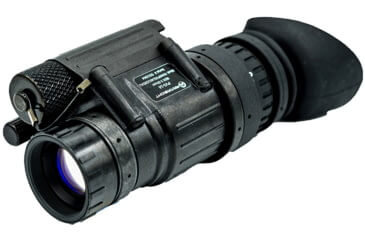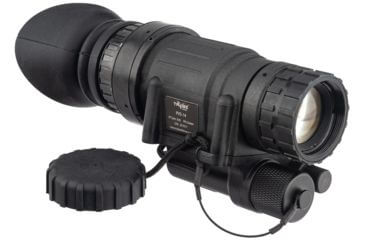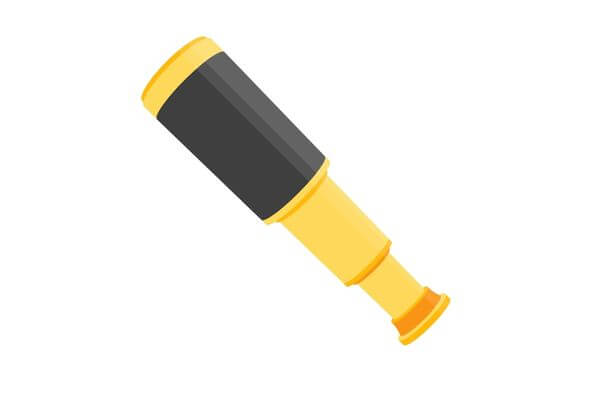This site contains affiliate links. As an Amazon Associate, I earn a commission from qualifying purchases at no extra cost to you. Full Disclosure Here.
On the hunt for a lightweight, versatile Night Vision (NV) tool? An NV Monocular ticks the right boxes.
I’ll introduce key terminology and need-to-know info when shopping for an NV Monocular to meet your needs. I’ve divided the monoculars by type, PVS-14, NVM-14, thermal imaging, and video capture/streaming models.
The products included in this guide range widely in terms of their pricing. I’ve included everything you need to know about each product to help you decide which ones best match your needs and budget.
At A Glance: Best Night Vision Monocular for the Money in 2024
- Best overall: Armasight PVS-14 Bravo Gen 3 IIT
- Best value PVS-14: TRYBE Optics Gen3 PVS-14 NV Monocular
- Best NVM model: AGM Global Vision NVM PVS-14
- Best recreational model: Sionyx Aurora PRO NV action camera
- Best thermal imaging monocular: FLIR Scout TK Handheld
- Simplest design: Night Owl Optics 3-Power NOXM50 Night Vision Monocular
- Most compact: Carson NV-200 Mini Aura Digital Night Vision Pocket Monocular
- Best for video and stills capture: Luna Optics 6-36x50mm Monocular
- Best range: BUSHNELL EQUINOX Z2 6X50MM NIGHT VISION MONOCULAR
- Best budget option: Crownz Monocular Telescope
Also Read: 7 Best Night Vision Scopes in 2022
Let’s take a closer look.
10 Best Night Vision Monocular
| IMAGE | PRODUCT | |
|---|---|---|
Best overall  | Armasight PVS-14 Bravo Gen 3 IIT
| VIEW ON OpticsPlanet → |
Best value PVS-14  | TRYBE Optics Gen3 PVS-14 NV Monocular
| VIEW ON OpticsPlanet → |
Best NVM model  | AGM Global Vision NVM PVS-14
| VIEW ON Amazon →VIEW ON OpticsPlanet → |
Best recreational model  | Sionyx Aurora PRO NV action camera
| VIEW ON Amazon →VIEW ON OpticsPlanet → |
Best thermal imaging monocular  | FLIR Scout TK Handheld Thermal Imaging Monocular
| VIEW ON Amazon →VIEW ON OpticsPlanet → |
Simplest design  | Night Owl Optics 3-Power NOXM50 Night Vision Monocular
| VIEW ON Amazon →VIEW ON OpticsPlanet → |
Most compact  | Carson NV-200 Mini Aura Digital Night Vision Pocket Monocular
| VIEW ON Amazon →VIEW ON OpticsPlanet → |
Best for video and stills capture  | Luna Optics 6-36x50mm Digital Day & Night Vision
| VIEW ON Amazon →VIEW ON OpticsPlanet → |
Best range  | BUSHNELL EQUINOX Z2 6X50MM NIGHT VISION MONOCULAR
| VIEW ON Amazon →VIEW ON OpticsPlanet → |
Best budget option  | Crownz Monocular Telescope
| VIEW ON Amazon → |
1. Best overall: Armasight PVS-14 Bravo Gen 3 IIT
The best night vision tech in a rugged, waterproof, lightweight chassis, the Armasight PVS-14 Bravo features a Gen3 Image Intensifier Tube (IIT) with manual gain control. It also has 64-72/LP/MM resolution, autogating, and an integrated IR illuminator that extends night vision over 400 yards.
Elbit makes the Gen3 tubes used in Armasight’s PVS-14 models. ELbit supplies IITs used in NV monoculars by the US Military. ELbit Bravo tubes are tested for 12,000 hours of continuous use.
The clever design puts the IR and low-battery indicators in your field of view (FOV). A wide aperture of f1.26 in a 19mm lens gathers available light. The high-quality IIT enhances this ambient light for maximum effect.
I found the FVO of 40 degrees, typical on PVS-14s, sufficient for everyday use, and 17mm of eye relief works for me. Armasight produces a model with an extended FOV of 51 degrees for enhanced situational awareness. Manual focusing can give you a clear image as close as 10″. The action of the focusing ring is firm but smooth.
I like having the option of using a CR123A battery instead of an AA. This battery type marginally brings the weight down, and both options provide a battery life of up to 50 hours. IP65 environmental rating means the Armasight Bravo will withstand plenty of punishment in extreme temperature conditions, resisting dust, water, and physical shock.
All this weighing in at 0.7 Lbs makes this an easy go-to monocular for various tactical and recreational activities. It won’t disappoint, but there may not be enough to justify paying more than for comparable models with pretty minor differences in quality.
Pros
- Tough and durable
- Excellent optics
- Gen 3 IIT offers maximum NV clarity
Cons
- Expensive
- Battery life can drop as low as 24 hours, depending on usage.
2. Best value PVS-14: TRYBE Optics Gen3 PVS-14 NV Monocular
Like the Armasight, the TRYBE PVS-14 can be handheld or mounted on a head unit, helmet, weapon, camera, or camcorder.
The TRYBE has more extended eye relief than the Armasight, at 25mm. It’s worth trying both out to see which gives you the best eye box. It has the same 40-degree FOV. Minimum focus can also get you a little closer at 9″.
Trybe is comparable to the Armasight on battery life, coming in consistently at around 50 hours. The Trybe model falls behind the Armasight in the effective range due to the lower grade IIT. Using the Trybe, I found that it failed to bring up the same level of detail much past 300 yards.
User-adjustable gain is via an easily accessed dial. A pinhole cap allows you to use the monocular in brighter conditions by reducing light ingress to a minimum.
This PVS-14 model provides most of the features of the more expensive Armalight, with a noticeable reduction in effective range but few other shortfalls. This monocular is a stellar buy if you don’t need the additional range of the more expensive model.
Pros
- Worth the money for a PVS-14 model
- Lightweight and rugged
- Wide range of model variations
Cons
- Lower spec IIT than more expensive models
- Increase in artifacts (black spots) over higher grade models
- It has an overly complicated mounting system
3. Best NVM model: AGM Global Vision Night Vision Monocular PVS-14
The AGM Global Vision PVS-14 NL1 is a military-grade Gen 2+ night vision monocular designed for hunting, tactical operations, and survival scenarios. Compared to bulkier models like the Wolf-14, the PVS-14 NL1 is compact, lightweight, and optimized for hands-free use. It is helmet and headset-compatible, making it an excellent choice for users who need a high-powered NVG solution for extended wear.
With a Gen 2 image intensifier tube, the PVS-14 NL1 offers crisp night vision performance at a more accessible price than Gen 3 models. The autogated power supply enhances visibility in dynamic lighting conditions, while manual gain control lets users fine-tune brightness. Its rugged waterproof construction (IP67-rated) ensures durability in harsh environments.
The unit features multi-coated optics, a 45-51 LP/mm resolution, and a built-in infrared illuminator for improved visibility in total darkness. Whether for wildlife observation, security, or tactical missions, this high-performance digital NV monocular delivers reliable night vision capabilities.
Pros
- Lightweight, compact, and helmet-mountable
- Gen 2+ IIT with manual gain control
- Waterproof and shock-resistant
Cons
- Lower resolution than Gen 3 models
- IR illuminator has limited range
4. Best recreational model: Sionyx Aurora PRO NV action camera
The Aurora pro uses digital light amplification rather than analog, as the units above. See my buyer’s guide below for a list of digital vs. analog pros and cons.
Along with capturing video and stills, the most significant selling point of the Aurora over the PVS-14s is that with some ambient light, or IR illumination, it gives full-color definition rather than just green or white.
However, the Aurora can’t compete with PVS-14 models in near darkness. In this way, the Aurora is comparable to Gen2 IITs, with high digital noise levels and dark spots.
Recoil-activated 30-second clips (15 seconds before and after) are a neat feature to capture what your rounds are hitting when mounted on a weapon. Like most NV monoculars, the Aurora can handle the recoil from 5.56/.223 only. Larger calibers will damage the unit.
Video resolution tops out at 720P, so this isn’t a serious videography tool, but it’s okay to capture a kill on video for me. Likewise, stills are acceptable if not great.
The square viewscreen can be awkward on a head or helmet mount. If you’re moving it around at all, you end up with a diagonal view which can be distracting.
The Aurora Pro comes with a great pressure-sealed hard case, comparable to a Pelican.
Pros
- Large storage capacity
- Lower cost than PVS-14 models
- Multi-info HUD display
Cons
- 2-hour battery life
- Lower resolution and clarity than PVS-14 models
Also Read: 17 Best Long Range Calibers
5. Best thermal imaging monocular: FLIR Scout TK Handheld Thermal Imaging Monocular
It’s worth considering a thermal imaging monocular as your primary NV tool or as a backup. Where night vision amplifies ambient light, thermal imaging sensors pick up radiated heat.
Thermal imaging systems will work in total darkness, whereas night vision needs something to work with – starlight, streetlights, whatever it might be, but you’ll get nothing in complete darkness.
The FLIR Scout is a great backup option if you’re using NV. Thermal imaging can be more helpful to spot nearby game or to recover a fallen animal that might be hard to spot through brush when relying on NV. However, following moving targets can be a little hit-and-miss, as the unit sometimes pauses to recalibrate.
It’s light, only 6oz, small enough for a pocket, and easily operated with one hand. At 50-75 yards, you can easily make out shapes, and at 100, you’ll get a clear thermal image, but not necessarily any idea of what it is you are looking at!
I’ve found it works at more than 100yds, and you can sometimes guess what you see by the movement pattern of the thermal blob.
The scout is weather resistant, boots up in seconds, and has good battery life.
Pros
- Lightweight
- Easy single-handed use.
- Handy for spotting insulation gaps and heat leaks in the house
Cons
- The Lo-res viewing screen is adequate but not great
- 5 hr or less battery life (rechargeable)
- Narrow FOV
6. Simplest design: Night Owl Optics 3-Power NOXM50 Night Vision Monocular
The NOXM50 provides a decent balance of cost vs. function for applications where you don’t need high-level resolution and clarity. IR illumination is effective in supporting ambient light up to around 70 feet.
It feels solid and well made in my hand and has some environmental sealing, although it is weatherproof rather than waterproof. While not great at magnification, image quality is consistent throughout the 5x zoom range.
The IR illuminator means you can still use this monocular at close ranges without other ambient light. Still, the illuminator does increase its height, making it less pocketable than other monoculars here. It lacks the head or helmet mounting facility of the PVS-14s and the Aurora Pro.
Its battery life is pretty decent at 45-100 hours, depending on how often you switch on the IR illuminator. The NOXM50 runs on two CR123 lithium batteries.
Pros
- Higher magnification at low weight
- All glass optics at a low cost
- Easy single-hand focusing and operation
Cons
- Gen1 tube means noisy images
- Lacks an eye shroud
- Bulkier than some monoculars
- Narrow FOV
7. Most compact: Carson NV-200 Mini Aura Digital Night Vision Pocket Monocular
Digital imaging and a small screen give a low-resolution picture, but it still transmits a usable degree of enhanced night vision. This tiny monocular is an excellent gadget in your pocket for low-level nighttime exploration or scanning a dark environment.
You can take this monocular at 1.9 oz and less than 3″ lengthways. Carson claims a range of 146 feet, although you’re not going to get much detail at that distance. Image brightness can be adjusted through three intensity levels, giving you a brighter image at the highest level.
The Carson NV-200 uses digital amplification and a low-res viewing screen. This viewer provides a black and white rather than green-tinged image, which is okay for any use, not requiring a detailed, low-noise picture. Remember that this monocular lacks the build to resist water or dust.
It is a handy, small, and lightweight tool for use in an old-school photographic darkroom, scanning the yard at night, or navigating a forest trail if you’re in a pinch.
Pros
- It fits in any pocket
- Super lightweight
- Softtouch, tactile easy grip exterior
Cons
- Narrow FOV (19 degrees)
- Occasional light bleed from viewing screen edges
Also Read: 20 Best Hiking GPS
8. Best for video and stills capture: Luna Optics 6-36x50mm Digital Day & Night Vision Monocular LN-G3-M50
A must-have gadget if capturing HD video in low light is your aim. The Luna Optics LN-G3-M50 gives you a direct HD view using a hi-res AMOLED-Q display and records via your choice of framerate and resolution, up to 1080p and 12.2mp stills.
A powerful IR illuminator gives you assisted lighting up to 436 yards and works pretty well. You can switch between full-color, black and white, or a digital simulation of green phosphor for viewing and recording. The image quality is pretty good, comparable to Gen3 analog. Great for things like stargazing.
The objective lens is wider than most at 50mm and offers 6x optical magnification. An additional 36x digital zoom is available, but image quality drops off at the higher end.
You can power this unit with 2x CR123A/CR123R batteries or a 5V/2A power bank. However, given the IR illuminator’s strength, this feels slightly underpowered. The batteries drain fast, making it a dubious option for longer wilderness trips. It ships with 8 GB of memory, which you can upgrade to a max 128 GB micro SD card.
Pros
- Widescreen AMOLED-Q display
- Blu-ray quality video recording
- 6x optical zoom
Cons
- Image quality drops when using digital zoom
- Short battery life
9. Best range: BUSHNELL EQUINOX Z2 6X50MM NIGHT VISION MONOCULAR – 260250
The Bushnell has a wide FOV, 222.6′ at 1000 yards, a 40mm wide objective lens, and a powerful built-in IR illuminator, meaning you can spot targets up to 1,000 yards over open ground. Trees or other obstructions will block the IR illumination, however.
Relatively poor battery life means you can’t keep this on all the time, so using it while on the move can be a hassle. This unit is better suited to operate from a fixed position. The IR illuminator is very powerful, which is excellent for the range of the device, but it eats up battery charge quickly.
Wifi streaming works okay but often with a lag of a second or so, which interferes with focusing. The device will occasionally freeze up or require a reboot when transferring images or video.
This monocular is an excellent choice if your primary aim is surveillance of your property, spotting game at a distance over open ground. The Bushnell is quite bulky but does have a built-in tripod mount.
Pros
- Fantastic range
- Wide objective lens
- Live streaming feature
Cons
- Poor battery life
- No autofocus
- Lo-res viewfinder
10. Best budget option: Crownz Monocular Telescope
The Crownz Monocular Telescope Day Low Night Vision High Power Monocular is an excellent option for light use.
One advantage of this cheap unit is the NV function can be disabled completely, meaning you can use it as a daylight monocular too.
The Crownz monocular offers a surprisingly wide range of features, including a 10x zoom, environmental proofing, a 50mm objective lens, and clear optics.
NV capability is hardly earth-shattering, but I found it helpful in scoping out areas of shadow under the moonlight at near to medium distances. It’s definitely a steal!
The Crown Monocular comes with a mini tripod and mobile phone adapter, a nice touch. There’s nothing complicated here at all, and you can set it up in seconds on the tripod or with a phone. The focus ring is nicely ergonomic, and you can adjust focus quickly and easily with one hand.
Did I mention that it’s also lightweight and robust? This one is hard to beat for both day and night use.
Pros
- High powered magnification
- HD video capture
- Supplied with a compact tripod and mobile phone adapter
Cons
- We couldn’t find any!
Buying Guide

There are quite a few factors involved in choosing the right NV monocular.
Rugged construction
The best night vision monoculars will last you a while. It is possible to get decently-made cheap scopes, but if you want something that’s not going to fall apart while you’re out on a hunt, look for an NV monocular that can withstand different types of weather and, ideally, is shock/drop-proof too.
Magnification

Of course, an NV monocular without magnification might be fine for your purpose, but I would still recommend picking one with a range – it’s always better to have something you might need rather than miss a shot because you couldn’t zoom in quite enough.
Also Read: 10 Best Red Dot Magnifiers in 2022
Battery life
Finding a monocular with a long-lasting battery is tricky, so I picked ones that offer a range of battery life. Most of these scopes should suit you if you’re only out for a few hours. Otherwise, I’ve included NV monoculars with rechargeable batteries so you can squeeze more use out of them in the field.
Image Intensifier Tubes (IITs)
You’ll find different grading systems on the net, some ranking generations from 0 to 4, others from 1 to 3. For this review, I’ll stick with 1 to 3, noting that the difference between Gen 2+(Wolf NVM-14) and Gen 3 (the two PVS-14 models) is significant. Gen3 IITs are a major step up from Gen2 in image quality and lower noise levels and artifacts.
Not all Gen3 tubes are created equal, however. The Elbit tube in the Armasight PVS-14 is rated for 12,000 hours of continuous use rather than the more usual 10,000 hours, will degrade at a slower rate, and has a slight edge over lesser tubes in terms of image clarity and range.
White or green phosphorus?
White is more expensive, from a few hundred dollars to as much as $1,000 per unit. For me, white reduces eye strain when used for extended periods, and clarity is generally better when compared to green, but the difference isn’t huge.
NV monocular types
PVS-14
Many NV monoculars come under the military acronym PVS (Portable Visual Search) -14, which designates a particular housing design for an image intensifier tube. Current model PVS-14s use single AA batteries and are fitted with an IR illuminator and manual adjustable objective Focus, Diopter, and Gain Control. To meet the PVS-14 standard, the monocular must be equipped with a Gen3 tube.
Although the basic design remains the same across models, features and the quality of build and materials vary. For example, all PVS-14 types are compatible with a wide range of accessories for increased magnification or attachment to a camera.
PVS-14s can be mounted on a weapon as a standalone or for use with a scope. Bear in mind, though, that anything above a 5.56 will cause recoil damage to the unit. Even shooting 5.56 can damage a consumer-level PVS-14 if you are shooting a lot with it mounted.
NVM 14
This range of NV monoculars offers many of the features of a PVS-14 but at a lower cost. On the downside, NVM-14s tend to be bulkier and heavier and, like the Wolf-14 model featured here, tend to house Gen2+ IITs rather than Gen3s.
Digital vs. Analog
Analog NV has been around longer than digital, so we expect to see improvements in digital units over time. Here’s a quick comparison between them:
- Digital versions consume more power, leading to shorter battery life.
- Digital sensors are not prone to damage from excess light as IITs are. However, autogating and auto cutoff features on high-end analog PVS-14s and other monoculars reduce the potential for damage.
- For the same reason, a digital monocular can be used during the day, while an analog NV monocular can only be used in low light.
- Digital device performance doesn’t degrade as quickly as analog.
- Some Gen3 analog units work without an IR illumination. All digital units need supplementary illumination.
- Digital NV devices use an IR wavelength higher than 850nm, which is invisible to animals, a significant advantage for night hunters.
- You can use digital NV devices to record video and photographic images.
- Digital NV devices are less recoil sensitive than consumer analog versions.
- Analog units still beat digital on resolution and image clarity.
The figure of Merit (FOM)
FOM is the standard used to measure the overall performance of an analog IIT. FOM is a product of resolution x signal-to-noise ratio. A higher FOM number means higher resolution and lower noise and other image distortions.
I haven’t quoted the individual FOM for any analog devices above, as each comes in various options with different tubes. The highest rated here is the Elbit Bravo grade in the Armasight PVS-14. Military-grade NV monoculars use Pinnacle-grade IITs, which have a notably higher FOM rating on average.
FAQs
If you’re still wondering about NV monoculars, here are some commonly asked questions and answers.
Typically an NV monocular will allow you to see out to around 1,000 yards, but how much clarity you’ll have at that distance will vary. A high-end monocular like the Armasight PVS-14, used with a quality magnification accessory, will give you enough detail to determine what you’re looking at. Still, cheaper units will have more noise and lower resolution.
High-end thermal imaging monoculars with telephoto lenses will return a heat signature at over 1,500 yards. However, like those reviewed here, the average consumer model will give well-defined images up to around 75-120 yards and return a more or less identifiable blob image at 400 yards or more.
8x-10x is about the maximum for a usable image. At this magnification, however, a tripod or other support is advisable. Hand-holding the device will mean that any slight movement of the unit translates into a jumpy image, making it hard to focus on one point.
High-end PVS-14 units with pinnacle Gen3 IITs are standard issues for the US military and NATO partners.
Not without a source of IR illumination. NV imaging tubes amplify available light. They can work with very low levels of ambient light, but there needs to be something there to amplify.
However, thermal imaging monoculars only need a heat source and can pick out anything giving off heat in any light conditions.
Also Read: Best Spotting Scope for 1000 yards
Conclusion
If you want the best consumer model for any low-light activity, then I highly recommend the Armasight PVS-14 Bravo. You can attach it to a phone or camera to capture stills and video. If your primary aim is to capture high-quality video in low light, it’s hard to beat the Sionyx Aurora PRO NV action camera for quality and versatility.
An NV monocular combined with a thermal imaging device like the FLIR Scout TK Handheld Thermal Imaging Monocular is a great setup to cover every eventuality. A lightweight thermal imaging monocular can save a lot of time recovering an animal in the dark.
As you can see, though, there are a lot of different NV monoculars for a wide range of uses. I hope this guide has helped help you to choose the NV tool that is right for your needs.


